Endodan Interactions
There are 879 drugs known to interact with Endodan (aspirin/oxycodone), along with 25 disease interactions, and 1 alcohol/food interaction. Of the total drug interactions, 275 are major, 582 are moderate, and 22 are minor.
- View all 879 medications that may interact with Endodan
- View Endodan alcohol/food interactions (1)
- View Endodan disease interactions (25)
Most frequently checked interactions
View interaction reports for Endodan (aspirin / oxycodone) and the medicines listed below.
- acetaminophen
- Actos (pioglitazone)
- adapalene topical
- Advicor (lovastatin / niacin)
- albuterol
- Aldactone (spironolactone)
- amoxicillin
- Aspirin Low Strength (aspirin)
- Augmentin (amoxicillin / clavulanate)
- calcium carbonate
- Celebrex (celecoxib)
- celecoxib
- Colace (docusate)
- colchicine
- finasteride
- furosemide
- gabapentin
- glipizide
- lisinopril
- Lortab (acetaminophen / hydrocodone)
- metformin
- methyl salicylate topical
- metoprolol
- niacin / simvastatin
- omeprazole
- rosuvastatin
- simvastatin
- terazosin
- tolterodine
- verapamil
Endodan alcohol/food interactions
There is 1 alcohol/food interaction with Endodan (aspirin / oxycodone).
Endodan disease interactions
There are 25 disease interactions with Endodan (aspirin / oxycodone) which include:
- coagulation
- impaired GI motility
- infectious diarrhea
- prematurity
- asthma
- acute alcohol intoxication
- drug dependence
- hypotension
- intracranial pressure
- respiratory depression
- gastrointestinal obstruction
- GI toxicity
- renal dysfunction
- Reye's syndrome
- adrenal insufficiency
- liver disease
- renal dysfunction
- seizure disorders
- urinary retention
- arrhythmias
- biliary tract disease
- anemia
- dialysis
- G-6-PD deficiency
- hepatotoxicity
More about Endodan (aspirin / oxycodone)
- Endodan consumer information
- Compare alternatives
- Drug images
- Side effects
- Dosage information
- During pregnancy
- Drug class: narcotic analgesic combinations
Related treatment guides
Drug Interaction Classification
| Highly clinically significant. Avoid combinations; the risk of the interaction outweighs the benefit. | |
| Moderately clinically significant. Usually avoid combinations; use it only under special circumstances. | |
| Minimally clinically significant. Minimize risk; assess risk and consider an alternative drug, take steps to circumvent the interaction risk and/or institute a monitoring plan. | |
| No interaction information available. |
See also:
Further information
Always consult your healthcare provider to ensure the information displayed on this page applies to your personal circumstances.


